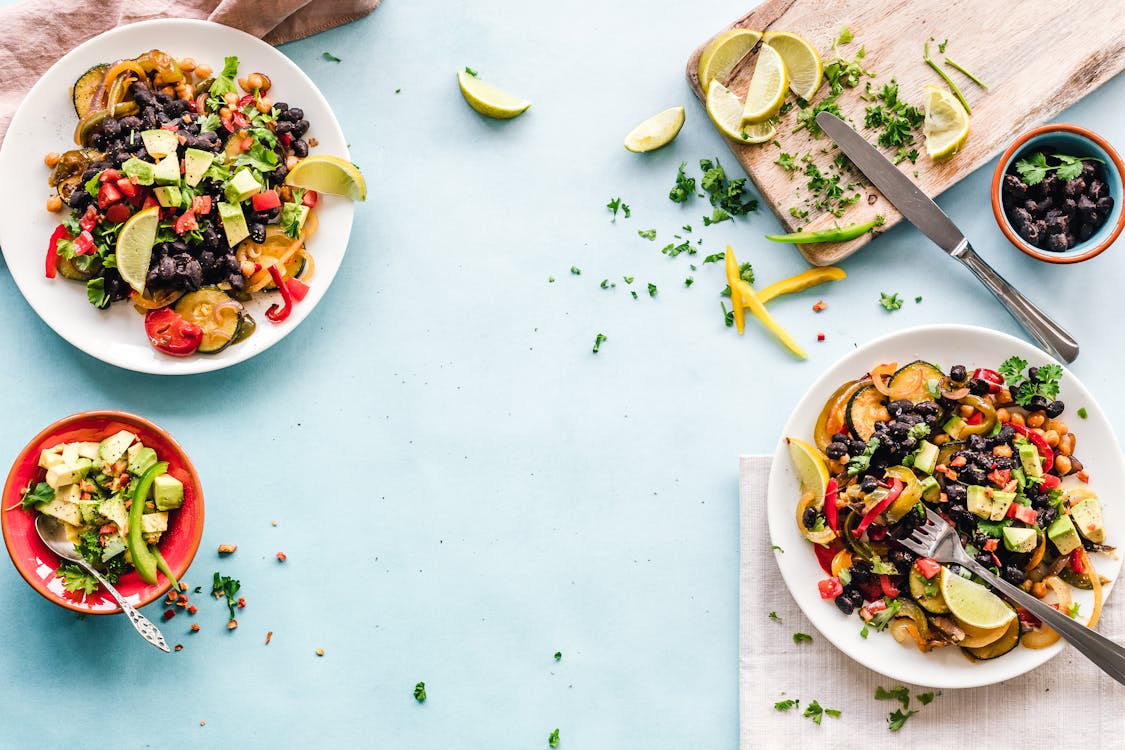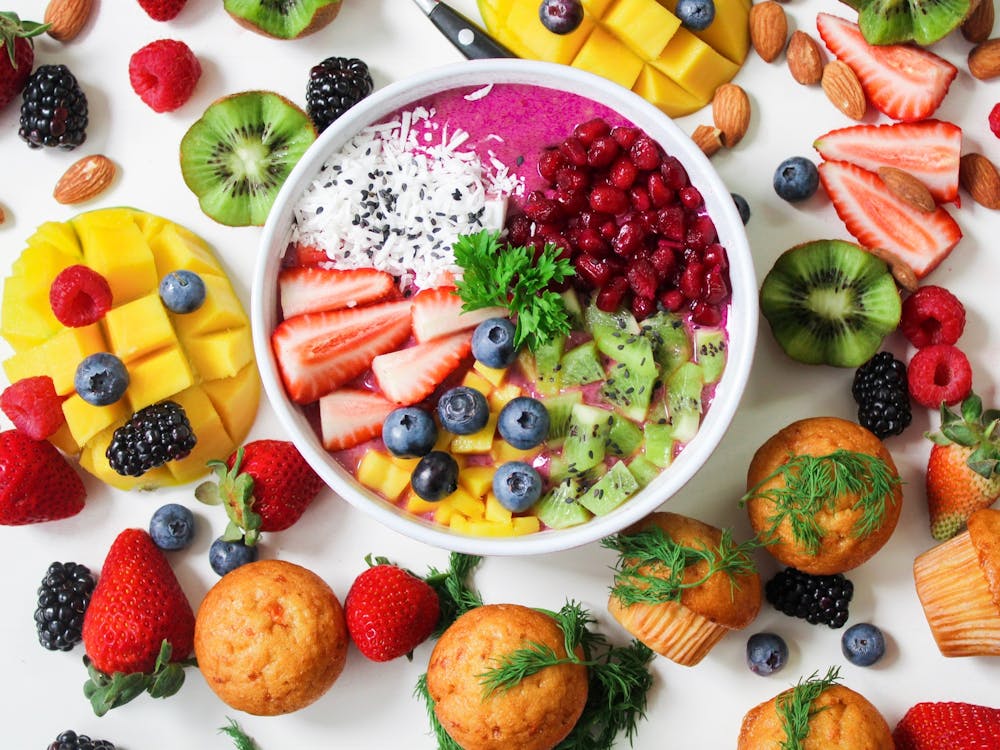Feeling lost in a sea of diet fads, conflicting advice, and complicated nutrition jargon? You're definitely not alone. Building an effective nutrition plan to fuel your fitness and transform your physique can feel overwhelming, but what if I told you the fundamentals are actually much simpler than you think? This guide, inspired by a fantastic deep dive into nutrition basics, is here to cut through the noise and give you the foundational knowledge you need to succeed.
Whether your goal is to shed fat (cutting), build muscle (bulking), or simply feel more energetic and healthy, understanding how to fuel your body properly is non-negotiable. We're going to break down the essentials: calories, macronutrients (protein, fats, and carbs), and practical strategies like tracking and meal prepping, so you can finally build a nutrition plan that works for *you* and delivers real, sustainable results.

Unlock your fitness potential by understanding the power of good nutrition.
Get ready to ditch the confusion and embrace a clear, actionable approach to eating for your best self!
Table of Contents
- The Starting Point: Understanding Calories (BMR & TDEE)
- Decoding Macronutrients: Your Body's Building Blocks & Fuel
- Putting Knowledge into Action: Tracking, Prepping & Progress
- Foundations First: Whole Foods Over Extreme Fads
- Your Beginner Nutrition Questions Answered
- Nutrition as a Pillar of Your Holistic Wellness
The Starting Point: Understanding Calories (BMR & TDEE)
At its core, managing body weight and composition comes down to energy balance – calories in versus calories out. To navigate this, you need to understand two key terms:
- Basal Metabolic Rate (BMR): This is the number of calories your body burns at complete rest just to keep you alive (think breathing, blood circulation, cell production). It's your baseline energy need.
- Total Daily Energy Expenditure (TDEE): This is your BMR *plus* all the calories you burn from physical activity (exercise, walking, chores) and the thermic effect of food (calories burned digesting). Your TDEE is your total daily calorie burn.
Online TDEE calculators can provide a useful starting estimate for your daily caloric needs. If your goal is:
- Cutting (Fat Loss): You'll aim for a caloric deficit (consuming fewer calories than your TDEE).
- Bulking (Muscle Gain): You'll aim for a caloric surplus (consuming more calories than your TDEE).
- Maintenance: You'll aim to consume calories around your TDEE.
Key Insight: While TDEE calculators are a great starting point, they are estimates. Individual metabolic rates and activity levels vary. You'll likely need to adjust your intake based on your progress and how you feel. Personalization is key!
Decoding Macronutrients: Your Body's Building Blocks & Fuel
Once you have an idea of your calorie target, the next step is understanding macronutrients ("macros"): protein, fats, and carbohydrates. These are the nutrients your body needs in larger amounts.
Protein: The Muscle Builder & Repair Crew

Protein is vital for muscle repair, growth, and overall bodily functions.
- Calories: 4 calories per gram.
- Functions: Essential for building and repairing tissues (including muscle!), producing enzymes and hormones, and supporting immune function.
- Good Sources: Lean meats (chicken, turkey, fish), eggs, dairy (Greek yogurt, cottage cheese), legumes (beans, lentils), tofu, protein powders.
- Key Takeaway: Active individuals, especially those aiming for muscle growth or preservation during a cut, generally need a higher protein intake.
Fats: Essential for Hormones & Health (Not the Enemy!)

Healthy fats are crucial for hormone production, vitamin absorption, and brain health.
- Calories: 9 calories per gram (most calorie-dense).
- Functions: Crucial for hormone production, absorption of fat-soluble vitamins (A, D, E, K), brain health, and providing concentrated energy.
- Good Sources: Avocados, nuts (almonds, walnuts), seeds (chia, flax, pumpkin), olive oil, fatty fish (salmon, mackerel).
- Key Takeaway: The old myth that "fats make you fat" is outdated. Healthy fats are vital. Focus on monounsaturated and polyunsaturated fats, and limit saturated and trans fats.
Carbohydrates: Your Primary Energy Source

Choose quality carbohydrates for sustained energy and vital nutrients.
- Calories: 4 calories per gram.
- Functions: The body's primary and preferred source of energy, especially for your brain and during intense exercise. Fiber, a type of carbohydrate, is crucial for digestive health.
- Good Sources (Complex Carbs): Whole grains (oats, brown rice, quinoa), fruits, vegetables (especially starchy ones like potatoes and sweet potatoes), legumes.
- Key Takeaway: Quality matters! Prioritize complex carbohydrates rich in fiber and nutrients over simple sugars and highly processed carbs, which can lead to energy crashes and health issues if overconsumed. Minimize added sugars.
🥦 READY TO MASTER YOUR NUTRITION & TRANSFORM YOUR BODY? 🥦
✅ The Ultimate 30-Day Holistic Wellness Journey Provides the Structure and Support You Need!
🎯 JOIN NOW: Get Personalized Nutrition Guidance & Delicious, Healthy Recipes!
👇 CLICK HERE TO BUILD YOUR BEST BODY FROM THE INSIDE OUT! 👇
UNLOCK The Ultimate 30-Day Holistic Wellness Journey! →(Fuel your greatness with a plan designed for sustainable success!)
Putting Knowledge into Action: Tracking, Prepping & Progress
Understanding calories and macros is the first step. Now, let's talk about practical application.
Effective Nutrition Tracking with Apps
Using calorie and macronutrient tracking apps (like MyFitnessPal, Cronometer, or the Buff App mentioned in the video) can be incredibly helpful, especially when you're starting. They allow you to:
- 📱 **Log Your Food Intake:** See exactly what and how much you're eating.
- 📊 **Monitor Calories & Macros:** Ensure you're hitting your targets.
- 💡 **Learn About Portion Sizes & Food Composition:** Develop a better understanding of the nutritional value of different foods.
Tracking doesn't have to be forever, but it's an excellent tool for learning and establishing good habits.
Meal Prepping for Consistency

Meal prepping saves time and helps you stay consistent with your nutrition goals.
Meal prepping – preparing some or all of your meals in advance – is a game-changer for consistency. It:
- 🕒 **Saves Time:** Cook once, eat multiple times.
- 💰 **Saves Money:** Less takeout and impulse food purchases.
- ✅ **Ensures You Hit Your Goals:** You control the ingredients and portion sizes.
- 🚫 **Reduces Decision Fatigue:** No more wondering "what's for dinner?" when you're tired and hungry.
It doesn't have to be complicated. Start by prepping a few staple items like cooked chicken, roasted vegetables, or a big batch of quinoa.
Monitoring Progress: Beyond the Scale
While the scale can be one tool, don't rely on it solely. Monitor your progress using a variety of methods:
- ⚖️ **Weigh-Ins:** Track trends over time, not daily fluctuations.
- 📸 **Progress Photos:** These can reveal visual changes the scale might miss.
- 💪 **Performance in the Gym:** Are your lifts going up? Can you do more reps?
- ⚡ **Energy Levels & Focus:** How do you feel throughout the day?
- 📏 **Measurements:** Track changes in your waist, hips, etc.
This data-driven approach, combining quantitative and qualitative feedback, helps you make informed adjustments to your plan.
Foundations First: Whole Foods Over Extreme Fads
The video offers sage advice: **start with a foundation of whole, unprocessed foods and a balanced approach before even thinking about extreme diet trends** like keto, intermittent fasting, or carnivore. These diets can be restrictive, hard to sustain, and may not be suitable or necessary for everyone, especially if you haven't mastered the basics of balanced nutrition first.
Key Insight: Sustainability is paramount. Build healthy eating habits with whole foods that you enjoy and can maintain long-term. This creates a strong nutritional base from which you can make further refinements if needed.
Your Beginner Nutrition Questions Answered
What's the difference between BMR and TDEE?
Your Basal Metabolic Rate (BMR) is the number of calories your body burns at complete rest just to maintain vital functions (breathing, circulation). Your Total Daily Energy Expenditure (TDEE) is your BMR plus all the calories you burn from physical activity, digestion, and daily tasks. TDEE is the more practical number to use for setting calorie goals for weight loss (cutting) or muscle gain (bulking).
Are fats bad for you if you're trying to lose weight?
No, fats are not inherently bad for weight loss and are essential for health. They play crucial roles in hormone production and vitamin absorption. The key is to choose healthy fats (like those in avocados, nuts, seeds, and olive oil) and consume them in appropriate amounts within your overall calorie goals. Over-consuming any macronutrient, including fats, can lead to weight gain.
How much protein do I really need?
Protein needs vary based on activity level, goals, age, and overall health. Active individuals, especially those looking to build or maintain muscle, typically need more protein than sedentary individuals. General guidelines often range from 0.8 grams per kilogram of body weight for sedentary adults to 1.6-2.2 grams per kilogram for highly active people. It's best to align intake with your specific fitness objectives.
Is meal prepping necessary for good nutrition?
While not strictly 'necessary' for everyone, meal prepping is a highly effective strategy for maintaining consistency with your nutrition plan. It helps you control portions, ensure you're hitting your macro targets, save time during busy weeks, and avoid making less healthy food choices when you're hungry and unprepared.
Should I try an extreme diet like keto or intermittent fasting for quick results?
The video wisely advises building a solid foundation with whole-food nutrition and understanding your basic caloric and macronutrient needs *before* considering extreme diets. While some people find success with diets like keto or intermittent fasting, they can be challenging to maintain, may not be suitable for everyone, and often require a good understanding of nutrition to implement healthily and effectively. Sustainability is key for long-term results.
Want a structured plan that takes the guesswork out of healthy eating and fitness?
Explore The Ultimate 30-Day Holistic Wellness Journey →Nutrition as a Pillar of Your Holistic Wellness
Understanding and implementing sound nutrition principles is undeniably a cornerstone of achieving your fitness goals. But it's also a critical component of your overall holistic wellness. The energy you get from food impacts your mood, your focus, your sleep, and your ability to handle stress.
The Ultimate 30-Day Holistic Wellness Journey recognizes this vital connection. It provides not just fitness guidance but also comprehensive support for your nutritional needs, helping you build a balanced, enjoyable, and sustainable eating plan that fuels your body and mind. It helps you move beyond simply counting calories to truly nourishing yourself for peak performance and vibrant health.
Conclusion: Take Control, Fuel Your Success!
This beginner's guide has equipped you with the fundamental knowledge to start building an effective nutrition plan. Remember, it's about understanding the basics – calories, macros, whole foods – and then applying that knowledge consistently through practical strategies like tracking and meal prepping. Be patient with yourself, listen to your body, make adjustments as needed, and prioritize sustainability over quick fixes.
You have the power to fuel your fitness, transform your physique, and enhance your overall well-being. Start today by taking one small, informed step!
Further Exploration & Authoritative Perspectives
For credible, science-backed nutrition information, explore these resources:
The Dietary Guidelines for Americans (DGA) provides comprehensive recommendations for healthy eating patterns.
The Academy of Nutrition and Dietetics (eatright.org) offers a wealth of information from registered dietitian nutritionists.
Examine.com provides unbiased analysis of nutrition and supplementation research.
For information on sports nutrition, the American College of Sports Medicine (ACSM) and the National Strength and Conditioning Association (NSCA) offer valuable insights.
✨ READY TO NOURISH YOUR WAY TO A STRONGER, HEALTHIER YOU? ✨
✅ The Ultimate 30-Day Holistic Wellness Journey Integrates Smart Nutrition with Effective Fitness!
🎯 GET STARTED TODAY: Receive Expert Guidance, Meal Ideas, and a Supportive Community!
👇 CLICK HERE TO BEGIN YOUR HOLISTIC TRANSFORMATION! 👇
JOIN The Ultimate 30-Day Holistic Wellness Journey NOW! →(Transform your relationship with food and unlock your body's true potential!)
Suggested Labels: Nutrition Basics, Fitness Nutrition, Macronutrients, Calorie Tracking, TDEE Calculator, Meal Prepping, Fat Loss Nutrition, Muscle Gain Nutrition, Healthy Eating, Whole Foods, Holistic Wellness, The Ultimate 30-Day Holistic Wellness Journey
